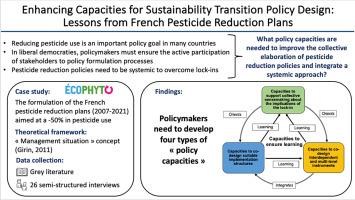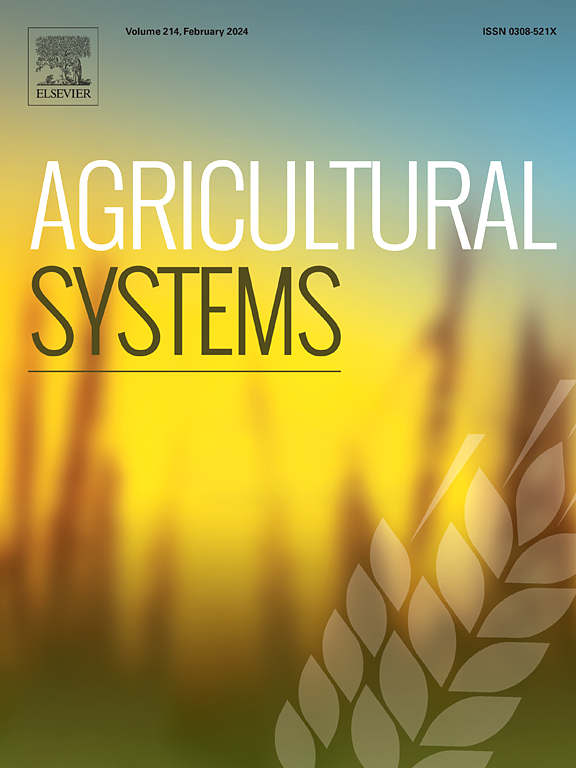Enhancing capacities for sustainability transition policy design: Lessons from French pesticide reduction plans
IF 6.1
1区 农林科学
Q1 AGRICULTURE, MULTIDISCIPLINARY
引用次数: 0
Abstract
CONTEXT
Reducing pesticide use has become an important policy objective in several countries, yet many have failed to reach their goals. Policies need to be more systemic to address lock-ins hindering pesticide reduction. To do so, policymakers must improve policymaking processes, while ensuring active stakeholder participation. This requires specific policy capacities, which have not yet been characterized.
OBJECTIVE
This article aims to identify policy capacities needed to improve the collective elaboration of pesticide reduction policies and integrate a systemic approach.
METHODS
We studied the collective elaboration of the French pesticide reduction plans. We built a narration of the policy process organized by policymakers, based on semi-structured interviews and an analysis of grey literature. We then reflected on which policy capacities policymakers needed to better manage the policy design process, using the “management situation” concept.
RESULTS AND CONCLUSIONS
Our results show that to better design pesticide reduction policies, policymakers lacked four types of interdependent “policy capacities”: capacities to support collective sensemaking about lock-ins, to co-design interdependent and multi-level instruments, to co-design suitable implementation structures and to ensure learning. These results highlight an issue of dynamic capabilities in public organizations.
SIGNIFICANCE
Our results provide concrete proposals to improve design processes for pesticide reduction policies aiming at systemic transformations: there is a need to develop new methods, tools, analytical resources and training programs for policymakers, to support the development of the policy capacities identified. These results also suggest avenues for future action-research between public management, systemic agronomy, sustainability and design sciences.

提高可持续性过渡政策设计的能力:法国农药削减计划的经验教训
内容提要 减少农药使用量已成为一些国家的重要政策目标,但许多国家未能实现其目标。政策需要更加系统化,以解决阻碍减少农药使用的禁锢因素。为此,政策制定者必须改进政策制定过程,同时确保利益相关者的积极参与。本文旨在确定改善农药减量政策的集体制定所需的政策能力,并整合系统方法。方法我们研究了法国农药减量计划的集体制定。我们通过半结构式访谈和对灰色文献的分析,对政策制定者组织的政策制定过程进行了描述。我们的结果表明,为了更好地设计农药减量政策,政策制定者缺乏四种相互依存的 "政策能力":支持集体感知锁定的能力、共同设计相互依存的多层次工具的能力、共同设计合适的实施结构的能力以及确保学习的能力。我们的研究结果为改善农药减量政策的设计过程提供了具体建议,旨在实现系统性转变:需要开发新的方法、工具、分析资源以及针对政策制定者的培训项目,以支持已确定的政策能力的发展。这些结果还为公共管理、系统农艺学、可持续性和设计科学之间的未来行动研究提出了建议。
本文章由计算机程序翻译,如有差异,请以英文原文为准。
求助全文
约1分钟内获得全文
求助全文
来源期刊

Agricultural Systems
农林科学-农业综合
CiteScore
13.30
自引率
7.60%
发文量
174
审稿时长
30 days
期刊介绍:
Agricultural Systems is an international journal that deals with interactions - among the components of agricultural systems, among hierarchical levels of agricultural systems, between agricultural and other land use systems, and between agricultural systems and their natural, social and economic environments.
The scope includes the development and application of systems analysis methodologies in the following areas:
Systems approaches in the sustainable intensification of agriculture; pathways for sustainable intensification; crop-livestock integration; farm-level resource allocation; quantification of benefits and trade-offs at farm to landscape levels; integrative, participatory and dynamic modelling approaches for qualitative and quantitative assessments of agricultural systems and decision making;
The interactions between agricultural and non-agricultural landscapes; the multiple services of agricultural systems; food security and the environment;
Global change and adaptation science; transformational adaptations as driven by changes in climate, policy, values and attitudes influencing the design of farming systems;
Development and application of farming systems design tools and methods for impact, scenario and case study analysis; managing the complexities of dynamic agricultural systems; innovation systems and multi stakeholder arrangements that support or promote change and (or) inform policy decisions.
 求助内容:
求助内容: 应助结果提醒方式:
应助结果提醒方式:


